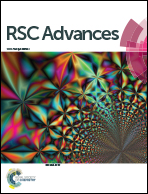Promising activated carbon derived from sugarcane tip as electrode material for high-performance supercapacitors†
Abstract
We present a simple, low-cost method for producing activated-carbon materials from sugarcane tips (ST) via two-step pre-carbonization and KOH activation treatment. After optimizing the amount of KOH, the resulting ST-derived activated carbon prepared with a KOH to PC-ST mass ratio of 2 (ACST-2) contained 17.04 wt% oxygen and had a large surface area of 1206.85 m2 g−1, which could be attributed to the large number of micropores in ACST-2. In a three-electrode system, the ACST-2 electrode exhibited a high specific capacitance of 259 F g−1 at 0.5 A g−1 and good rate capability with 82.66% retention from 0.5 to 10 A g−1. In addition, it displayed a high capacitance retention of 89.6% after 5000 cycles at a current density of 3 A g−1, demonstrating excellent cycling stability. Furthermore, the ACST-2//ACST-2 symmetric supercapacitor could realize a high specific energy density of 7.93 W h kg−1 at a specific power density of 100 W kg−1 in 6 M KOH electrolyte. These results demonstrate that sugarcane tips, which are inexpensive and easily accessible agricultural waste, can be used to create a novel biomass precursor for the production of low-cost activated carbon materials for high-performance supercapacitors.



 Please wait while we load your content...
Please wait while we load your content...